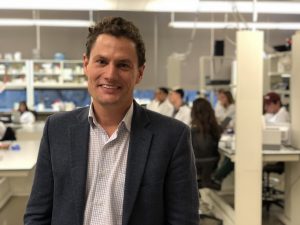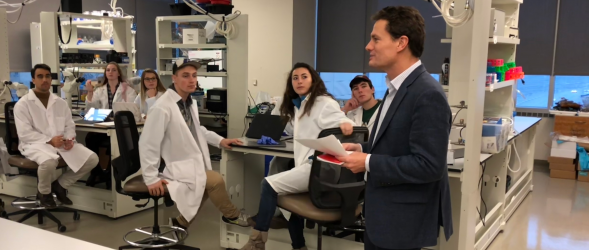Sam Rikkers was born and raised in south central Wisconsin but has managed to make his mark in far-flung places. A graduate of Columbia University with a Master of International Affairs, he has served the Peace Corps in Zambia, earned a Law Degree from the University of Wisconsin and served in President Obama’s White House as Director on the Energy and Environment Team in the Presidential Personnel Office. Most recently he was the Administrator of the USDA Rural-Business Cooperative Service and the Director of the Rural Opportunity Initiative at Georgetown University’s Business School. We at WID could not be more pleased thattiny earth he has “come home” to make the Tiny Earth flourish here, across the country, and beyond.

What do you work on?
I direct Tiny Earth, which addresses two critical challenges. First, antibiotic resistance is rearing its head as one of the most important medical challenges facing humans in the 21st Century precisely at a time when pharmaceutical companies have shifted resources away from developing new antibiotics. Second, to meet economic demands over the next decade in the United States alone, an additional one million STEM graduates need to join the workforce, yet the number of students pursuing STEM degrees is not enough to meet the economy’s increasing demand. Tiny Earth tackles both of these challenges head-on by crowdsourcing the discovery of new antibiotics with a global network of undergraduate student-scientists who will be hooked into STEM careers by the opportunity to conduct original science and the appeal of potential discovery.
What are your tools for analysis?
Questions and distillation. As a non-scientist leading a global program at a world-class research institution, I have a lot to learn. My tools for analysis start with questions. I find people are generally forthcoming with information if (1) you’re sufficiently gracious, and (2) you might be able to help them achieve their objectives. As a former litigator, I then apply legal reasoning. Making the case for the Tiny Earth means succinctly articulating its objectives and benefits. And while succinctness takes effort, the process of distilling a project or idea to its essence is critical to promoting it to more and more circles.
What are your tools for writing?
Coffee and four eyes. Kurt Vonnegut noted on several occasions that smoking and coffee sped his creative process and made his synapses fire faster. Although I’m not a smoker, coffee provides me the focus and persistence to effectively communicate an idea or an argument on paper. In addition, having someone else read my writing is key. The second set of eyes almost always illuminates connections and gaps in my thinking and makes it better.
What are your tools for collaboration?
Tiny Earth is a highly collaborative network of partner instructors spanning 39 states and 15 countries across 200 separate academic institutions. Conference calls, Google Hangouts, Google Documents and other online and virtual tools keep the program afloat. But what nurtures and fuels Tiny Earth’s creative arc and rapid growth is its decentralized structure and shared sense of mission. Empowering instructors to passionately and autonomously implement Tiny Earth and give of themselves works once they’ve tasted the power of discovery-based learning to grab and hold students’ curiosity.
What is your ultimate tool for discovery?
Crowdsourcing undergraduate students. Each year approximately 10,000 Tiny Earth undergraduate students from across the country and world hunt for novel antibiotic structures in the soil. Their collective research results in tens of thousands of antibiotic activity-producing soil extracts. Most of these extracts won’t yield new discovery. Yet, Tiny Earth’s magic lies in students knowing they are part of a collective effort where the chances of discovery are great.


You must be logged in to post a comment.